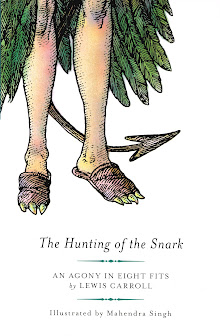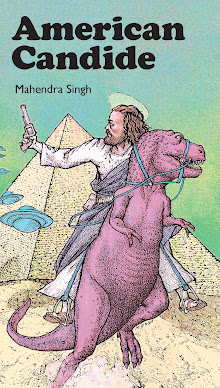
He had forty-two boxes, all carefully packed,
With his name painted clearly on each:
But, since he omitted to mention the fact,
They were all left behind on the beach.
The loss of his clothes hardly mattered, because
He had seven coats on when he came,
With three pairs of boots — but the worst of it was,
He had wholly forgotten his name.
The subject for today's sermon is the number 42, personified by the late, great Douglas Adams (pictured above at his easel). The late Mr. Adams has been dragooned by this artist into performing what is essentially a Magrittian pratfall involving bits of canvas, packing crates and some pokey things. He is ably assisted by the charming Xie, AKA Alexandra Kitchin, a young Englishwoman clad in a Chinese costume delineated by the very best India ink, the entire ensemble having once furnished the subject of a photograph by Lewis Carroll.
This artist has not felt it necessary to depict the seven coats and six boots mentioned in the above stanzas, owing to the fact that since the clothes make the man, the commutative principle of haute couture allows the man to make the clothes. Therefore, the sartorial and ontological nudity of this man (still un-named, un-manned and un-drawn) is his own lookout. No doubt, if left alone, nature will have its way and his coats and boots would multiply and eventually replenish his wardrobe (the commutative spirit of Victorian men's fashion was biblically fecund) and he will find himself the proud possessor of 42 coots and boats.
With these newfound portmanteaux in hand, we see our anonymous semi-protagonist depicted evacuating this barren strand for the ontologically, sartorially and spatially broader comfort of the next stanza, wiser by a factor of 42.








That character is xiè 灺 "candle-end". Very clever!
ReplyDeleteIt seems to be a combination of huǒ 火 fire, plut yě 也 representing a funnel or wash basin. intriguing...
This comment has been removed by the author.
ReplyDelete"The snuff of a candle" is one of the definitions that Fernando Soto tries to connect to "snark". I'm not sure he makes it... "The snuff of a candle" is a definition of "snirt", which is connected to "snark" in a way I'm not clear about, and won't be clear about until I have time to visit a library.
ReplyDeleteBut what's a little etymological laxness between gli snarchisti?
Yes, I tried to kill two birds with one stone there … I was worried that the characters were wrong, I had used an internet chinese site, it seemed serious & scholarly. I know that Xie isn't really involved in the Snark but it was too good a coincidence to turn up!
ReplyDeleteYour Dr Who piece really pleased me … if you ever get an idea for a superhero series involving people clad in 19th-century clothes with a penchant for surrealism, logic and linguistic games, let me know.
Which site did you use for the Chinese? Because I'm no longer sure. I can't find it on zhongwen.com. My Chinese is basically zero, but I can try to help you make sure it's accurate.
ReplyDelete...if you're concerned about it, that is... the look of the thing is of course more true than the truth...
ReplyDeleteNo, the truth must out!!!! I am always interested in the sort of linguistic goodies you unearth and I am eager to get to the bottom of this sino-boojumistic imbroglio … I cannt, as yet, find the site I used, I am still searching. Write to my email so I can get your add and I will send you, in the meantime, the screencapture of the ideogram from the site that I used. Unfortunately, I cropped out the url from it.
ReplyDeleteI do see the same xie character here, but this is not the site I used:
http://www.chinese-tools.com/tools/dictionary.html
I have to confess that of all the panels I have done so far, this panel is my favorite in the fiendishly-recursive department!
Bingo! Here it is …
ReplyDeletehttp://www.mdbg.net/chindict/chindict.php?page=worddictbasic&wdqb=candle+stub&wdrst=0&wdeac=1
Any Chinese speakers reading this are encouraged to weigh in. is this a legitimate use of the word? is this site reliable?
According to my wife (she is Chinese) the character is not used too often, but you use it correctly. In http://longwiki.net/%E7%81%BA you can see, that the letter is used for "candle end" (or "candle stub") in the PRC, in Taiwan, in Hongkong and in Korea. In Japan it is a uncommon Kanji (Unicode 707A).
ReplyDeleteThanks, Götz … this character made me nervous at first but I feel better about it now!
ReplyDelete